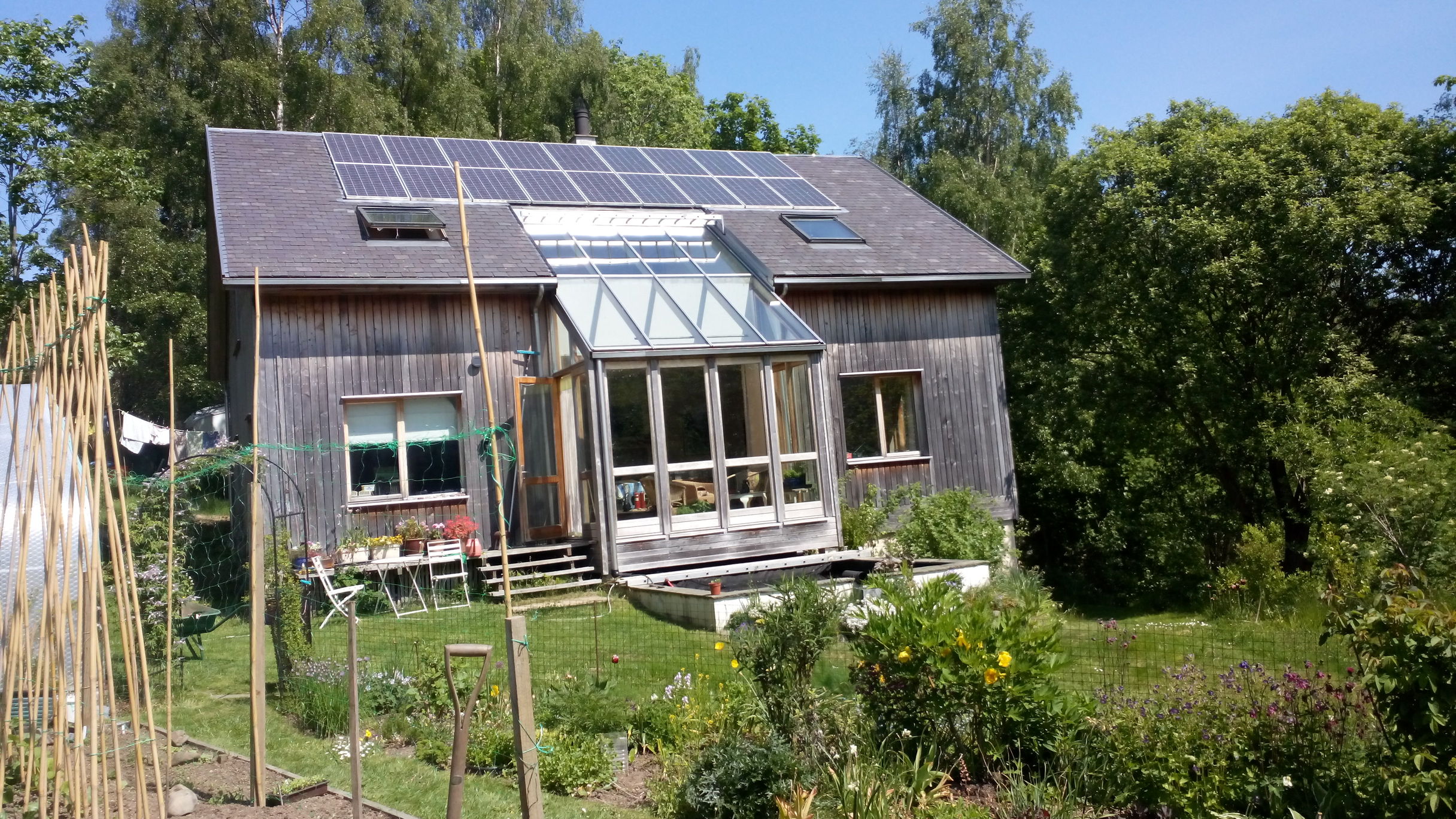
Edenhope
from the south
Unfortunately all the linked content on our site has been deleted by the site host. We hope to be able to repost it without delay. Meantime, if there is anything you especially need please drop us an email.
11 Feb 2010
This website, like the house, is under construction. If you wish to be informed of significant updates please email edenhope@riseup.net with 'Update' as the subject. Last updated on 14 Oct 2009
You can get an A4 2 page flyer about the project here.
The website concentrates on content. If you want it to look prettier...
EDENHOPE
Building a house that is financially and environmentally affordable and carbon neutral in construction and occupation
This web site is being updated from time to time with more information. If you want to be advised when significant updates occur send an e-mail to edenhope@riseup.net with 'update' as the subject.
This website has been provided to tell the story of the design and construction of Edenhope by Andy Swales and Sarah Eno to provide significant environmental benefit at affordable cost. Many of the techniques and experiences described may be of use as an example to others who wish to provide environmentally responsible housing, cost effectively. The write up has been partly financed by the Scottish Borders Woodland Partnership but the work itself and the opinions expressed, are entirely the work of the authors.

Edenhope
from the south
If there is one message to take away from our build it is that we can have carbon future proof housing now and without paying a significant premium. The materials and components are widely available and the skills within our grasp. We have only to make the moral choice to put it into effect.
Zero-heating design.
Wood/cellulose fibre carbon banking construction
Solar water heating
Solar (photovoltaic) off-grid electricity.
Heat recovery ventilation.
Breathable, air-tight construction.
Low/zero maintenance finishes.
Roof collected rainwater supply.
Sub-soil heat exchanger.
Passive solar.
Thermal storage.
Low cost to build and live in.
The high degree of integration in this project has made it difficult to write about in any sensible structured way. As I try to write about separate aspects they keep putting themselves back together again. If you know a better way let me know – maybe it should be a novel, play or film.
Edenhope is a house in many ways quite ordinary but in others completely unique. The intention was to see how far we could go, on a limited budget, in realising a house sustainably built and sustainable to live in.
The project began with the idea of financially and environmentally affordable housing elucidated and developed by Gokay Devici in the mid 1990s. (G. Devici: Towards Zero-heating). It progressed to one with implications relating to sustainability, fuel poverty, replicability, healthy building, cost of ownership, affordable housing, carbon footprint and future proofing.
In this design, affordability is extended to themes including construction, occupation and health. 'Carbon neutral’ only applies to some of the aspects of construction and occupation so 'sustainable construction', exemplified in the build, is closer to that which we aimed to achieve.
Embodied energy is widely used to indicate the ‘greenness’ of materials by quantifying the amount of energy consumed in production. However, ‘energy capital’ gives a better and more informative idea of the energy/carbon cost by including manufacturing, delivering and employing components. The most informative measure of the sustainability of a component is a Life Cycle Analysis or Costing (LCA) which assesses all the energy fluxes over the item's production, use and disposal.
It appears that UK energy/carbon standards (e.g. DTI Low Carbon Building Programme) refer to the energy/carbon cost of occupation of a building even though, depending on who you read, the energy cost of constructing a building is 2 to 4 times the energy used within it during the building's life. In our case the energy cost of construction is of equal importance to that of occupation so materials were chosen with low energy capital and which carbon bank to offset the use of energy/carbon heavy materials such as cement and metals. An informal Life Cycle Analysis guided the selection of many of the products and technologies employed.
Bath University's Index of Carbon and Energy provides further data. (http://www.bath.ac.uk/mech-eng/sert/embodied/)
Equally, attention was paid to other environmental costs. PVC, for example, is reputed to be polluting both in manufacture and disposal so alternative materials such as polyethylene were selected wherever possible. As a bonus using PVC free wiring and plumbing within the house makes it much safer in the event of a fire as toxic fumes are substantially reduced.
The dwelling's construction is unspecialised so it is substantially within the capabilities of general house builders especially because it is large made of wood and cellulose fibre (wood) products. This adaptable design is easily replicable for small or large developments, indeed the constructional method is ideally suited to prefabrication and multiple units.
A further aim was to build a zero-heating house. It is incidental that it complies with the Passive House Institute's certification requirements and a clutch of other low energy/carbon housing measures.
(more on Passive Houses: Passive Houses in Ireland
Part of designing a house which anyone could build or have built involves only using information in the public domain. We didn't have the opportunity to stray beyond this as information from government agencies (e.g. Building Research Establishment BRE, British Standards Institution BSI) or from university research were essentially hidden from us. Titles are published but there seems to be no means of judging their content without actually buying them and at £20-50 a time this is clearly not possible even if they would deal with us at all (which universities in general wouldn't).
On the plus side other countries, Local Authorities and particularly manufacturers are more than generous with their information and, among our UK institutions, the Timber Research and Development Association (TRADA) are much more helpful. For the cost of one 4 page BSI document, TRADA sell the excellent 250+ page 'Timber Frame Construction' handbook, a detailed 'How to...' and compendium of useful data.
The Masonite handbooks were essential but iLevel's TJI joist manual had more practical information about how to work with engineered I-beams. (http://www.ilevel.com/)
British websites tend to be very coy about actually telling you anything useful. You often have to 'register', it seems that style is important rather than content. German or USA sites for the same manufacturer are usually much more useful and informative.
I bought some CAT (Centre for Alternative Technology) books thinking they would give me valuable information but they always seemed to stop short of telling me what I needed to know – one had to contact (and pay) their consultancy services to get the crucial details. (But the publications are quite good introductions).
We wanted a 2 bedroom house that was both financially and environmentally inexpensive to build and occupy. It was to be simple to build without using specialised materials or skills and be a healthy house to live in.
Our budget was limited to what we could realise on the sale of our 2 bed rural cottage, say £80,000, plus whatever we could budget for ‘enhancements’ or items like renewable energy systems that, although they might increase the capital cost, would be cost effective over time.
The house had to be compatible with our interest in and commitment to the environment. So, for example, all the wood had to be FSC (Forest Stewardship Council: www.fsc.org ), PEFC (Programme for Endorsement of Forest Certification schemes: www.pefc.org/internet/html/ ) or equivalent. The carbon cost of the house had to be at worst net neutral both in construction and occupation – a carbon neutral life cycle. Similarly, other products and processes in the house's life cycle were to be environmentally benign.
The house had to help to make the most of the modest pensions we expect to get.
We would be doing the project management and much of and building work ourselves so the design and construction had to be straightforward and uncomplicated.
The house was to look like it belonged in the Scottish landscape and to a visitor would appear normal and familiar both inside and out.
We wanted to build a house that anyone could have. What we really wanted was to open the newspaper property supplement on a Thursday and have a choice of six so we could just go out and buy one, but we couldn’t so we had to build it.
Now that it is built we have a model for easily replicating the design.
In many cases low financial and low environmental cost go together both in construction and occupation. For example locally sourced larch cladding, on a LCA (Life Cycle Analysis), provides a low cost solution to weatherproofing and is sustainable in terms of environment, local economy and community. Similarly, a compact rectangular building without protrusions is both less expensive to build and highly energy efficient relative to more complex designs with offsets and dormer windows.
The house is a one and a half storey rectangular box with a pitched roof and protruding bay window. The box is the simplest and cheapest form for a building and has a low surface area to volume ratio so the heat losses are also low for the required accommodation. It is easy and cheap to design and build, the challenge is to make it look elegant and not boxy. The bay window is a relatively unaffordable enhancement. It is a locus of heat loss but also solar gain. It cost about £3500 more than simply glazing the centre section of the South wall but it was a costed decision to create this very light area and attractive architectural feature.
Constructional details for the box are also simplified and provide about 180m2 of flexible floor space (v.i. Structural Design). In developing the structural design for a shell that provided the required space and using standard components in a straightforward, easy to build frame, the guiding idea was ‘simpler – cheaper’.
All the construction materials were sourced from a local builders’ merchant or regional distributors. There was an aversion to buying ‘green’ materials at ‘jewellery’ prices. Occasionally this led to bizarre events such as buying German insulation products via a distributor in the Republic of Ireland as it was the most cost effective route.
Some components and materials that were originally selected were ultimately dropped for various reasons. There were the Scottish composite hardwood windows which were dropped because we couldn't get a specification for the windows; the PV panels for which the area on the roof was designed were no longer available when it came to ordering and the best arrangement for their replacements leave a 300 wide gap in the centre which we haven't decided what to fill with (any ideas?); we wanted Sasmox for lining the underside of the ground floor but it was only available by the pallet so we went for Fermacell, available by the sheet from the local builders merchant (ironically we used exactly one pallet of boards but if we had used Sasmox and damaged one we would have had to get another whole pallet).
The cost of ownership has several categories each of which was considered separately although, as with other parameters, they all interacted like mad.
The maintenance cycle for a conventional build consists of various repaintings, recoatings, repointings, rerenderings and replacements over the design life of the different components.
Untreated, uncoated larch cladding has a design life of 60yrs. The replacement cost is comparable to the cost of external repainting of a house which has to be done much more frequently.
The choice for windows came down to hardwood or aluminium clad softwood. The former was selected because of lower embodied energy. I asked the manufacturers what would happen if I didn't paint them - “They will go grey.” was the reply. I am now thinking of staining at least the south facing ones because they do go grey in the winter but in summer the wasps and bees strip the surface UV degraded layer to make paper for their nests (but they don't touch the larch cladding).
Plastic coated steel was considered for the roof but we were saved the agony of coming to terms with its energy capital by Historic Scotland insisting on slate. Locally reclaimed selected slate was sourced. I am always tempted to say that our slate is already over 100yrs old, of course it is millions of years old but as roof slates it has already had a long life and has many decades of useful life left. Reduce, Reuse, Recycle – the slates are reused and the simple roof design minimised waste (design life 50-100 years). Copper nails were used to maximise the length of the maintenance cycle.
Photovoltaic (PV) panels need a sub-roof to catch the water that leaks between the panels. Weatherproof mounting systems are available at a cost and, being aluminium, have an environmental cost too. Commercial systems use plastic 'trays' under the panels but doing a new build rather than retrofit enabled us to do something different in the way of roof integration. Onduline corrugated bitumen/fibre was used for the subroof. The fibre is cellulose (wood) so it does a bit of carbon banking and the corrugations ventilate both the roof and the backs of the panels (available from any builders merchant).
All the flashings, soakers, cappings and rainwater goods are stainless steel (Ugitop) so that our roof collected rainwater supply is not contaminated by metals. On a life cycle analysis stainless steel does brilliantly because of its indefinite life and at the end of its useful life it is one of the building materials most likely to be recycled (you never see it in skips). Also it is largely made from recycled metals and as it is a very high performance material, you don't need to use much of it (kilos) compared to, say, lead. The same material is used for sills and oversills for long life and architectural coherence.
The final external finish is the chimney head. This consists of a chimney pot of fired clay, a flaunch of self-coloured concrete and the stack with a self-coloured lime rich render. It is fairly well sheltered so we will see how it goes.
The energy performance of the building is crucial to its affordability in occupation and accurate energy modelling at the design stage is the way to achieve this. We were obliged to provide a SAP calculation [SAP 2005 Handbook] to conform to Building Standards requirements but a SAP calculator lacks the flexibility for serious use as a design tool. The Passive House Planning Package [Passive House Info.] provided the facilities needed to tailor the design for affordability. More specific energy models,for example for solar energy, were examined using RETscreen [Link to RETscreen renewable energy modelling].
The energy model is based on the selected worst case, we chose the conditions experienced in winter. This is relatively easy to satisfy but leads to a design which would overheat for most of the year so the model also indicates overheating and calculates how shading over windows and ventilation capacity will cope with these conditions. The modelling also predicts the percentage of the time that solar input alone will satisfy demand for warmth, hot water and power. Our target is 90-95% and experience to date confirms that the house is capable of exceeding this.
The insulation (300mm in floor and walls, 400mm in roof) is not excessive, neither is the window specification but coupled with close attention to air-tightness and a compact envelope the Passive House standard and a SAP rating of 100+ are attained. For the householder this means an annual space heating bill in the 10s of Pounds.
The water supply is roof collected rainwater augmented if necessary by cleaned recycled effluent (for non-potable uses). There is a small maintenance cost but comparable with the maintenance of any other rural private supply.
Effluent is treated by a conventional septic tank followed by 2 small reed beds, only required so that the water may be recycled, and thence to a small soakaway.
Electricity is provided using photovoltaic (PV) panels with battery storage and (biodiesel) generator back-up. There is a small annual maintenance cost and a pay-back period of less than 15 yrs, well under the 20+yrs life of the system. A grid connected system would be simpler to manage but because of the relatively high cost of the connection and low price paid for generated units it was considered financially unaffordable.
A solar thermal panel provides hot water backed up by a wood stove with back boiler and, if necessary, an immersion heater run off the generator. A small heat pump (up to 3kW output) will be considered if one becomes available in the UK.
Depending on who you read, the energy/carbon cost embodied in a house is 2 to 4 times as much as the energy/carbon cost of living in it for its design life so it is important to us that the house is energy/carbon neutral overall.
The following criteria were used when researching commoditised products to find the best combination to fulfil our objectives:
Selection of carbon banking materials: This essentially means wood, wood products and wood composites. The house weighs over 80T (including foundations), of this over 50T is forest derived. Contrary to expectations there is nothing light and fluffy about Warmcell when it is installed – the house is stuffed with over 15T of it.
Selection of low energy/carbon capital materials: An example of this is the use of clay plasters which use far less energy in their manufacture than gypsum plasters.
Selection of non-polluting materials: HDPE soil pipes and halogen free wiring were chosen in place of PVC products.
Intelligent use of high energy capital materials: The foundation design minimises cement use by obviating 'oversite' (a concrete slab over the whole of the building's footprint) and placing all concrete in form-work which minimises the amount used.
Good indoor air quality is ensured by using materials that are largely E0 for emissions (no more formaldehyde than the original tree), do not contain volatile organic compounds (VOCs) and using whole house heat recovery ventilation. Mention has already made of using solid wood toungue and groove flooring and water based varnishes. We also used OSB2 grade (orientated strand or Sterling board) rather than OSB3 where possible as it has a lower glue content and where higher emissions products were unavoidable they were sourced from reputable manufacturers who control the curing process so as to minimise emissions.
Paint finishes were all very low or zero VOC. Cork and linoleum (both about £16 per m2) are used as an alternative to wood for the finished floor.
Clay plasters are used to allow the house to breathe and provide thermal mass and hygrothermal buffering. This is where, during the day, when the house is warm, the clay absorbs heat and gives off water vapour helping to oppose overheating. In the evening the temperature tends to fall and the humidity rises so the clay absorbs water vapour and gives off heat thus opposing the temperature drop.(http://www.conservationphysics.org/wallbuff/wallbuff.php).
Using wood, clay and natural breathing finishes contribute to a comfortable natural 'feel' inside the house. Because of the zero-heating design one feels warm without feeling heated and comfortable at a lower measured temperature than in heated houses.
Everything in the design has a reason, in this case perhaps the clear lack of a reason to do anything other than good, ordinary. I could say that the project carries more weight if, to a casual visitor, it looks and behaves like any other small new house but it is more the case that much about it benefits from a long pragmatic tradition of doing what works, things like a pitched roof and ring main electrics.
I always say that I don't do architecture, I've just tried to design something that attracts the eye without making it water.
At the start we thought that the knowledge and ability for the design was in common circulation. Sustainable construction seemed to have been around for years and 'eco-building' was always in the press. Imagine our disappointment when we discovered that in general what passed for green building was largely a combination of myth, heresay and fashion without any foundation in judgement informed by any real knowledge. We found that anyone can join the 'eco-building' associations just by paying the membership fee and without necessarily having any particular knowledge or ability.
It is clear that had we not been able to acquire the necessary information ourselves then our chances of getting what we wanted was effectively zero. The situation has hardly changed 5 years later. Green wash and self-delusion are at least as prevalent in the construction industry as in any other. Even on Scotland's Sustainable Construction on-line directory, at the time of writing, the 'Timber' section is prefaced by a quote from 'Forests Forever', an organisation apparently established by the UK timber industry to counter the Forest Stewardship Council's promotion of sustainably sourced timber.
As we had already piloted the project through planning, were expecting to do the day to day project management and had a detailed, relatively simple design we had no need of an architect. Clearly some certifications were required and for those we worked with engineers. We were keen to keep the design cost low as it was only one house so most of the research, drawings and liaising with consultants and suppliers we did ourselves. Clearly for a development of several dwellings it would have been cost effective to outsource some of this work.
The development of the physical design of the house went in parallel with its energy model so that at each stage we could see what energy performance we could expect. This made it possible to see, for example, that we could achieve our target energy performance using double glazing so avoiding the expense of triple glazing which might have been expected to have been needed.
Following on from this came the selection and specification of materials on the basis of cost and sustainability. Essentially we were looking for commoditised sustainable materials so that they fulfilled both strands of our affordability criteria.
The house had to be financially affordable not just to build but also to occupy. The capital cost of the build was not the only consideration, it had to be affordable to build and use. This made it possible to use higher specification materials and components (e.g. hardwood windows) where they gained an advantage over their design life.
The house was to be simple and look conventional both internally and externally. We had a floor-plan for our required accommodation over two floors comprising large living room, kitchen, bathroom and hallway on the ground floor and 2 bedrooms, sitting/evening room and box-room on the first floor.
The aim was to avoid the appearance of a shed or holiday chalet and make it appear unambiguously a permanent residence.
Externally we used features such as masonry chimney, 150mm deep window reveals, moderately deep eaves and mixed horizontal and vertical cladding to give the house a solid, permanent, conventional and proportional appearance. The same metal finish was used for flashings, verges, gutters, downpipes and sills adding to the coherence and definition of the dwelling.
The larch cladding has a reeded machined finish (like corduroy) to get away from the rather agricultural look of sawn boards whilst avoiding using planed boards which is more expensive to produce and requires a higher overall grade of timber. With a design life of 60yrs larch is a very low maintenance finish as are the slates, self-coloured render on the chimney and stainless steel flashings, rainwater goods and sills.
Most importantly, because the house depends on solar energy, it had to face south and be unshaded, especially in winter. The site is not 100% ideal as the sun does not rise above the opposite hill until about 11.00 at mid winter.
Our preferred option was for pad foundations as it minimised the amount of concrete needed but because of the slope of the site (the ground at the NW corner of the house is almost 3m higher than the SE) we turned a problem into an amenity by excavating the area, building a retaining wall in blockwork and back filling. There is a row of 4 pillars (one of which is the underbuilding for the chimney breast) to support the ground floor at the 60/40 point (60% of the joist on one side of the support, 40% on the other. This gives the longest span for a continuous joist. If the joist was divided at this point the 60% piece would be too weak). This gave us an undercroft the same area as the house in which to accommodate our water storage and power system. The space had to be non-habitable and be permanently well ventilated so the headroom is only 1.8m and the E and W walls have alternate blocks missing in the top course. The area is classed as being ‘outside’ so all the materials need approval to Class 3 for exposure. The foundation is a strip of reinforced high strength concrete bonded into reinforcing rods run through the blockwork. This was all relatively expensive but overall it contains less concrete than a conventional build with trenchfill and an oversite concrete.
We did look at using limecrete but because of its limited strength it would have needed about 3 times as much lime as we used cement. This would probably nullify the embodied energy reduction which lime is said to achieve. We have attempted to research the embodied energy of lime and cement (http://www.bath.ac.uk/mech-eng/sert/embodied/) but only found contrary evidence.
There are now widely available ‘low embodied energy’ cement formulations which would be worth considering for future projects.(I have not been able to find a good, free review article but this one gives you the idea:Low_carbon_paper_135_Wimpenny.pdf )
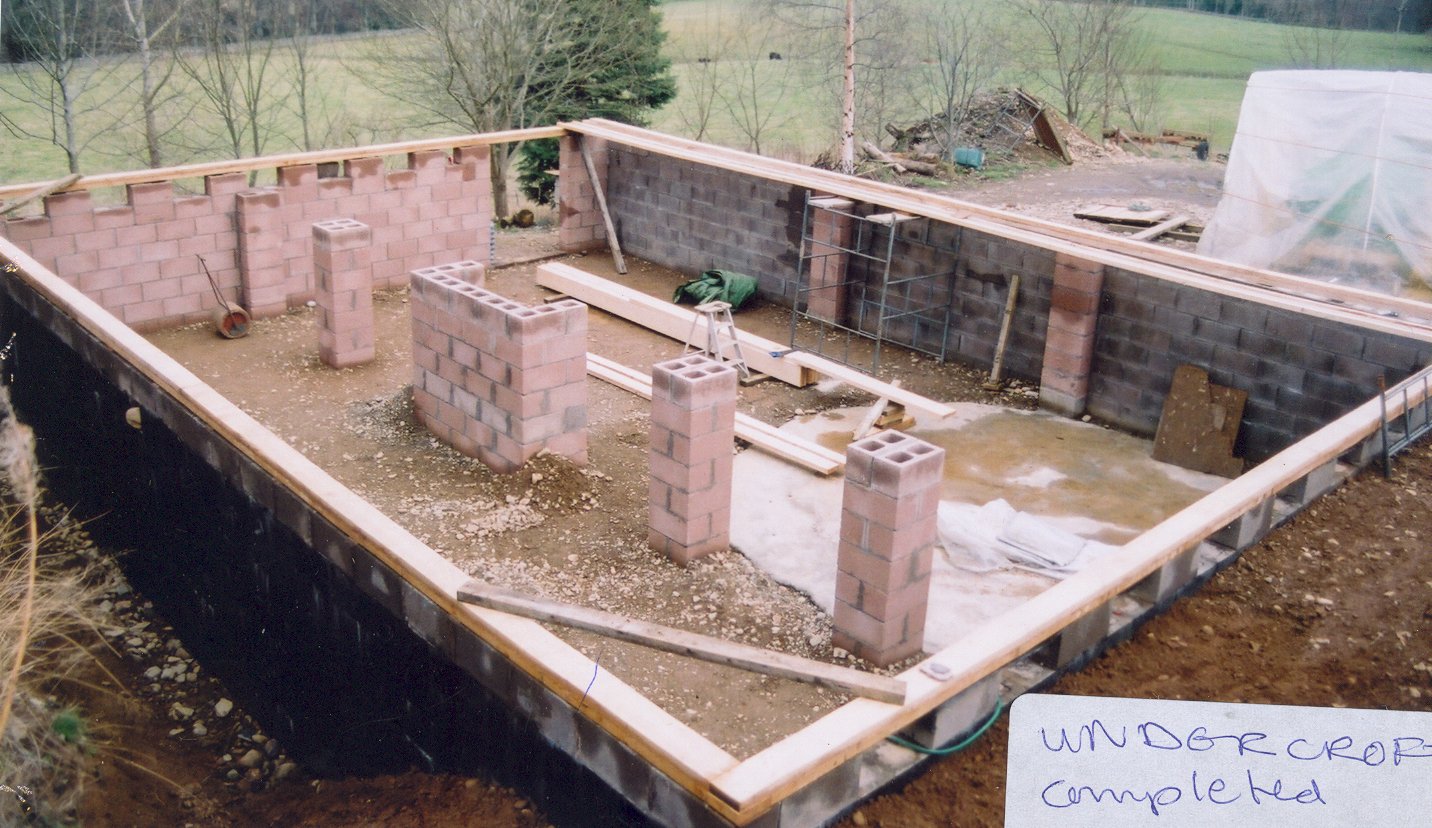
Pic
1: Underbuilding with sole-plate viewed from NW corner. U shaped
pillar is for hearth.
We used a balloon frame design using Masonite H grade (standard) beams. Lintols were made up using multiple beams nailed together or U sections using 3 beams (see Structural Details). The only exception to this was two Kerto (LVL or laminated veneer lumber - like slices of giant ply-wood on edge) beams in the first floor depth. The advantage of this method was that costs and component types were kept to a minimum and enabled the whole house to be fabricated and erected by hand.
Ironically the structural frame is significantly over specified because the joists, studs and rafters are sized for depth of insulation (300 joists and studs, 400 rafters) rather than adequate strength. There was no cost penalty and it lends a satisfying solidity to what is otherwise a lightweight construction. We were fortunate in finding a structural engineer who was highly experienced in designing with engineered timber products and understood the words ‘simpler, cheaper’.
The roof is supported on a ridge beam which in turn is carried on reinforced studs in the gable ends and two posts at the 1/3 points. These posts, instead of passing through the ground floor space to the foundations, are supported on beams in the first floor depth which carry the load to the South (front) wall and the 60/40 stud wall running transversely across the ground floor. This arrangement provides enormous flexibility in dividing the internal space. The first floor is clear apart from two load bearing posts supporting the ridge-beam so the space may be divided into, say, four bedrooms, bathroom and box room or, as we are doing, two bedrooms, sitting room and box room, with enough space to divide off a shower room and study at a later date.
The bay window is designed to be constructed from 50x150 planed C24 softwood erected on a projection of the ground floor which is in turn supported on two foundation pillars.
An important aspect of the design in relation to its energy performance is its airtightness an lack of cold bridges.
A computerised 3-D model of the house was produced so that all the components could be accurately dimensioned and we could be certain that it would all fit together. All the structural drawings are different views of this single model.
The most significant component of the energy design is that the house faces south. Other orientations are not disastrous but it seems perverse or negligent to build new houses without regard to solar gain for either heat or ambience.
The house is based on a zero-heating house designed by G. Devici Chartered Architects. A zero-heating house is not unheated but the heat is derived from energy consumed within the building for cooking, lighting, running the fridge, home cinema and other appliances, even body heat (about 400W per person). In addition to this is direct passive solar gain – even on a relatively dull day the clouds radiate long wave infra red which is captured by the low-e glazing. The south face of the house is relatively generous in glazing whilst the north has much less. To conserve the heat the ventilation system recycles the heat by warming the cool fresh air coming in with the warm exhaust air as it leaves. Overheating in summer is more of a problem than being too cool in winter. To address this fresh air can be drawn through a tube buried in the ground on the north side of the house (called variously a culvert, ground tube, Provencal well or subsoil heat exchanger). This gives air at about 12°C year round so it is pre-cooled in summer and pre-heated in winter. In addition simple solar thermal blinds can control heat gain during the day and reduce its loss at night.
The energy modelling mentioned above gave a heat loss for the whole house of under 2.5kW and this is borne out in practice.
The use of comprehensive energy modelling (which also relates to carbon balance) cannot be underestimated. Without these tools achieving a cost effective zero-heating design, comfortable all the year round, would be impossible to achieve.
Consideration was given to sinking a borehole but roof collected rainwater was a more attractive option as it was much less expensive in both financial and energy cost. Pumping water takes a lot of energy (try carrying 50 buckets of water per person up 10 stories every day) so letting gravity do the job looked more worthwhile. Briefly, water falling on the roof is collected in a buffer tank (pond) and then flows to a slow sand filter in the undercroft. The pond, with its ecosystem, allows settling of any debris, oxygenation and first stage digestion of nutrients and micro-organisms. The sand filter continues (virtually completes) removal of micro-organisms and nutrients (oligotrophication). The idea is that if there are no nutrients in the water then nothing, pathological or not, will grow in it so the water can then flow to the 25,000l clear well where it is stored in bulk. From there it is pumped to a 1500l gravity cistern on the hill, the bottom of which is about level with the house ridge and from which it runs, again by gravity, to the taps, &c in the house. The idea here is that we don’t have to run a pump to get water out of the taps. It also adds resilience to the system in that if the power fails (through fault, fire or scheduled maintenance) there is still a week’s worth of water supply available. The pump which tops up the gravity cistern is controlled by a float switch and timeswitch so that it only runs once a day during the daytime (when 'spare' electricity is availoable).
Once delivered to the house a conventional cartridge filter and UV steriliser (photo) complete the water treatment.
The clear well was sized by statistical analysis of 30yrs of monthly rainfall figures from a nearby weather station. The answer was 25,000l. If the system had been installed 30 years ago and there had been 4 people living in the house who didn’t practice conservation during droughts the system would never have run dry.
There is an additional facility to supply cleaned up recycled grey water for non-potable uses.
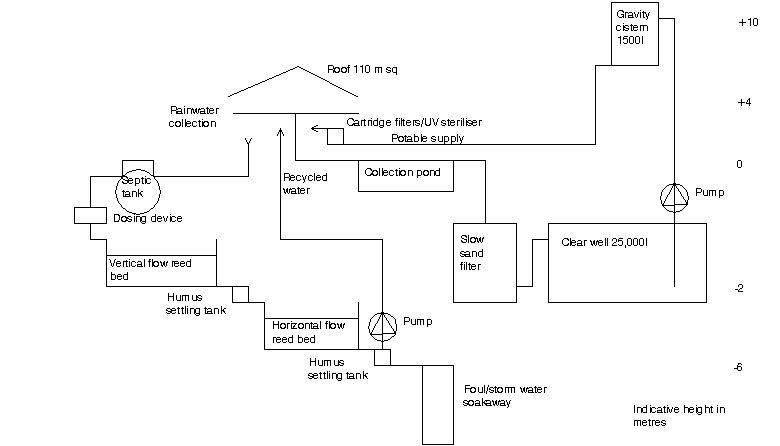
Pic
1: Water System Schematic
Waste water and sewage go to a conventional septic tank and could then discharge directly to a soakaway but since we want the facility to recycle the water the septic tank effluent is treated first in a small vertical flow reed bed then a horizontal flow reed bed. These do the same job as the sand filter, the ecosystems living in the reed beds consume the nutrients in the effluent, reducing biological oxygen demand and reducing pathogenicity; cleaning the water. The design of the reedbeds followed The Building Research Establishment Good Building Guide 42 parts a and b. Unfortunately it appears to be illegal for me to make available to you documents from the BRE or BSI. I am bemused. It was a great impediment in designing this project to not have access to documents from these sources without buying them especially as their published catalogues are so poor.
We didn’t think about going off-grid until we discovered the cost of a grid connection to the pole in the adjoining field. As it is we have a photovoltaic/battery system that has a maximum 15yr payback (decreases whenever energy costs increase) and a 15yr+ warranty on the major components.
The system is based on a daily energy consumption of between 3 and 6kWh. The system was designed using RETscreen modelling software using this consumption figure and climate data for our area. The model includes a back-up generator (can run on bio-diesel) in case of system failure or long, dark, grey periods. At present the system is sized to store 3 days of power but we are considering doubling this because the frequency of relatively long cloudy periods seems to have increased.
Solar thermal is to provide the bulk of water heating, again modelled using RETscreen, with a simple thermal store and back-up from a small stove with back boiler. Whilst developing the passive solar envelope we found that there was an excellent location for the solar thermal panel under the glazed part of the roof. This saved the cost of a weather proof box and, because it would never freeze, would make the system much simpler and cheaper. The panel would suffer some shading and loss of insolation by reflection off the glazed roof when the sun was at low angles but on the plus side solar thermal works best if it is kept warm and the location does get hot as it is an unventilated space in full sun at the high point of the ground floor envelope.
The panel is fixed at 55° from vertical. This is optimum for the equinoxes and, because it is less efficient at higher solar angles, helps to prevent overheating in summer. In winter it is also less efficient but the back boiler can make up for this.
Conventional solar thermal systems are designed mainly to pre-heat water, the final heating to the required temperature being done by electricity, gas or oil. In an off-grid, carbon neutral house the aim is to produce hot water, if possible, directly from the solar panel. We don’t use PV power to heat water because of the large amount of energy required (it would double our daily energy requirement) and solar thermal at 65%+ solar efficiency is much more cost effective than PV electricity (15%). A small solid fuel stove with back boiler will top-up the hot water when needed.
Heat recovery ventilation (HRV) is an integral part of the zero-heating model. The system is designed to extract 'used' air from wet, hot areas (bathroom, kitchen and first floor ceiling) and discharge fresh warmed air into living and bedroom areas. The air is carried in moderately oversized galvanized spiral ducting (Lindab). This is cheap, easy to install in a new house, is cleanable (a requirement in many countries) and avoids PVC. The oversizing makes the system quiet and saves on fan power without being significantly more expensive. One of the many advantages of using engineered timber I-beams is that within limits, one may make 125mm diam. holes in them without impairing their strength.
HRV only works if the building is airtight so that all the air entering and leaving the building goes through the HRV unit. Airtightness testing to a high standard is becoming the norm in building regulations. Passive House Certification (which attracts financial benefits for the householder in some countries) requires certificated airtightness to a high standard.
See drawings.
The construction is a standard balloon timber frame using Masonite engineered timber I-beams and panels(http://www.masonitebeams.co.uk/), blown cellulose fibre insulation(http://www.excelfibre.com/building/products3.html), standard double-glazed windows(http://www.vrogum.dk/?id=974), sawn larch wood cladding, slate roof and a concrete foundation. It was stick built on site although if being built now the shell would have been sourced pre-fabricated, pre-insulated and erected with weather resistant membranes (http://www.edenframe.com/). As well as the obvious attractions of this method it avoids having to do a detailed, dimensioned structural drawing which is a significant design overhead.
The construction is based on the Masonite EVT (Enhanced Vapour Transfer) system. The complete structure consists of (from inside to outside):
Inside to outside. (dimensions in mm)
Roof: U-value 0.09
Breatheable paint (including limewash – cheap and fun).
5 Clay based finish plaster
12.5 Gypsum plasterboard (no clay board available approved for 600 c/c)
6 Paneline fibreboard
BSK 410 vapour control paper (also used to achieve airtightness)
400 Masonite H grade I-beam rafters
Warmcell fill under pressure
9.2 Panelvent fibreboard
Pro-clima Solitex Plus breather membrane
Counter battens
Slate battens
Reclaimed Welsh slate
(Section under PV is Onduline pitch fibre corrugated roofing)
Ridge cap, flashings, etc in Ugitop SS
Wall: U-value 0.11
Breathable paint or breathable paint on recycled lining paper.
5 Clay based finish plaster
25 Clay based undercoat plaster
6 Paneline fibreboard
BSK 410 vapour control paper (also used to achieve airtightness)
300 Masonite R grade I-beam studs
Warmcell fill under pressure
9.2 Panelvent fibreboard
Pro-clima Solitex WA breather membrane
Battens
Board-on-board or flush lapped larch cladding
Ground floor: U-value 0.12
Structural floor board or boards with cork, Marmoleum or natural oak finish
12.5 OSB2 sub-floor (not needed but used as working platform and left in situ)
BSK 410 vapour control paper (also used to achieve airtightness)
300 Masonite H grade I-beam joists
Warmcell loose fill
12.5 Fermacell gypsum fibre board because it is technically Class3 exposure (should have been Sasmox but supply problematic)
Narrow voids in all elements (e.g. between stud and cripple or in composite Masonite lintols) filled with 40 Homatherm wood fibre insulation.
There are no cold bridges in the shell.
BSK 410 reduces the interstitial condensation risk without compromising the inherent breathability of the assemblage and provides a cheap and easy method to achieve a high degree of airtightness. The shell is genuinely breathable, not simply technically breathing. [Interstitial Condensation Risk Analysis-Roof]
Joist hangers, etc from Cullen of Fife – special range for I-beams.[Cullen Joist Hangers, &c] I think that Masonite was the only engineered timber I-beam to have UK approval for use as joists, studs and rafters.[Masonite BBA Cert.] Masonite products were selected because of their environmental credentials and because all their products are E0 for emissions (of formaldehyde), that is, no more emissions than from the original tree. This is largely because almost no glue is used in the beams or boards and also presumably because that is the standard they wish to achieve. All the timber is grown specially for the end use and the waste from the solid I-beam flanges, for example, is used to make fibre for the boards.
Warmcell from Excell Industries is an excellent low embodied energy insulation product for this project. Not only does it carbon bank but it is manufactured in the UK from recycled paper. There are 15T of it packed into the roof, walls and ground floor. Ideally it would be factory installed in prefabricated panels so that the correct density is achieved and the risk of settling obviated. [Warmcell 500]
The Pro-Clima Solitex breather membranes also have a significant waste wood fibre content as do the Fermacell ground floor underlining and the Onduline sub-roof to the PV panels. None of these products attracted a price premium and most were sourced through local builders merchants.
Our energy modelling showed that we could get the required performance from high specification double glazed windows and did not need the more expensive triple glazing.
When quotations were obtained for windows we found that pine windows made in the UK were about £9,000 but ‘Victoria Oak windows made in Denmark by Vrogum were only £8,000.
‘Victoria Oak’ comes from Australia and is an oak type wood in appearance and durability (eucalyptus spp [Victoria Oak]). We were advised that we could leave them unpainted if we did not mind them going grey. Vrogum prides itself on its good environmental credentials. Apparently, because the wood comes in large loads by ship, the carbon cost of transporting it is lower than shipping north European softwood to the factory by road. The printed Vrogum catalogue is the only one we have received from a major manufacturer on recycled paper. [Link to 22MB Vrogum Catalogue]
The untreated larch cladding was designed for low cost by using relatively narrow (100) sawn boards to help maximise the utilisation of the logs and a dressed rather than planed finish which was less expensive but still lifted the cladding from the rather agricultural look of plain sawn boards.
The 1st floor is grade 5 tongue and grove whitewood flooring which at £6 per square meter is inexpensive and when sanded and finished with a water based varnish look very good. They also avoid using a manufactured wood fragment board with its attendant off-gassing risk. Floorboards are E0 for emissions, engineered structural flooring is E1 at best.
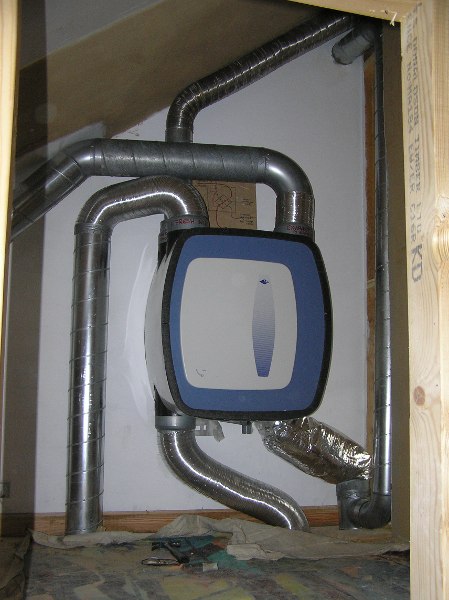
Pic
1: Itho HRU Eco3 in situ
The unit selected is the Itho Eco3. This has a number of advantages over other units in the same class the main one being that it has an automatic 100% bypass if the internal temperature of the house rises above a comfortable level. This means that on a sunny day the unit will switch from recovering heat to simply ventilating hence helping to prevent overheating within the dwelling. The counter current heat exchanger provides a high heat exchange efficiency (>90% in normal operation) and can win heat from highly humid air (steamy bathroom) by condensing the water vapour and discharging it via a drain. The unit will also automatically defrost itself. Finally it has the best performance factor in its class delivering over 10 times as much recovered heat in a year as electricity consumed. Its low energy consumption is assisted by thermal siphon through the ductwork with the cold inlet at ground level and warm air discharge at eaves level. [Itho HRU Eco3 Brochure] As mentioned above, fresh air can be drawn via a Provencal well (sub-soil heat exchanger) which also helps with overheating in summer by pre-cooling ambient air to about 12°C and conversely, in winter, it pre-warms the air to further minimise ventilation heat loss.
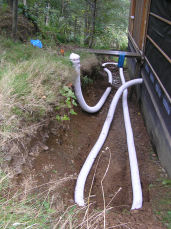
Pic
1: Subsoil heat exchanger before being back filled
Much has been written on the importance of good indoor air quality. Controlled ventilation plays an important role in this along with the use of indoor materials and finishes with intrinsically low or zero emissions. [Indoor Air Quality]
A stainless steel roofing product, Ugitop, is used to obviate metal contamination in the water. We could not find any authoritative evidence that Aluminium, zinc or copper would not be problematic and lead was obviously eliminated because of its known toxicity.
Using Stainless steel in sustainable construction may seem counter-intuitive because of its high embodied energy/carbon cost but it does have some features in its favour. It is largely made from recycled metals, it has an indefinite life, because of its strength you don’t need very much of it and at the end of its use it is one of the materials most likely to be recycled (you don’t see much of it in skips).
Ugitop is manufactured specially for roofing. It is tempered to make it workable with normal tin-smithing techniques and has an etched effect surface treatment to take the shine off it (not to be confused with Uginox which is terned – coated with zinc which for us would defeat the purpose). It is distributed in the UK by Associated Lead Mills so can be sourced from a builders’ merchant. Rainwater goods are also available made from the same material by Brandt Edelstahldach.
[Stainless Roofing Tech Manual]
This is based on 3m2 of solar absorber connected to a thermal store in parallel with a back-boiler model wood stove. The absorber was fabricated by AES in Forres (£250) and the 210l thermal store, a stock product, from Gledhill in Inverkeithing (£500). The system is complemented by a small 12v DC pump (£120) with a simple differential controller (£20) so the pump only comes on when the panel is hotter than the supply water in the bottom of the thermal store (otherwise the panel would re-radiate the heat in the store). An overheat thermostat is fitted and a thermal dump valve in case the controller fails or the whole store gets to over 90°C. It is a simple, conventional open vented system following the regulations and codes of practice for boilers (no valves on the flow pipe).
The stove has a maximum output of 5kW so does not require an air brick in the outside wall (which would short-circuit the HRV) and provides a focal point in the living room but is mainly needed for water heating and boosting the indoor temperature when the house is occupied after a period of absence.
The simple design is largely made possible by mounting the solar panel internally. There is no need for a frost protection system, anti-freeze or a primary circuit with coil. These factors along with the light duty panel enclosure make the system relatively inexpensive.
A thermostatic valve controls the supply of water to the panel (and back boiler). This ensures that the top half of the thermal store is heated to operating temperature before the bottom half so that the need for a heat top-up is reduced and the requirement for the solar panel to produce hot water is more often met.
The thermal store comes with a basic 70mm of insulation to which another 200mm is added (almost as much in total as the house itself). If the store is oversized or under-insulated it may loose heat more quickly than the solar panel can supply it. Insulation is cheap and the house does not need the casual internal heat gain from a cooling tank of hot water. Internal pipework is also fairly heavily insulated with 25mm wall thickness Armaflex.
[AES Solar Manual] [Gledhill Torrent Brochure]
A thermal store (TS) is the simplest and least understood of energy efficiency devices. It consists of a low-tech insulated tank of water which is heated by whatever sources are available and which supplies heat for hot water and/or space heating. The water in the TS is never drawn off, the same water just goes round and round – round the solar panel, the heat pump, the gas boiler, the underfloor heating, the heat exchanger (for the hot water service). They don't need to have any coils in them unless the heater or heating has to have its own isolated water supply and all the UK hot water cylinder manufacturers have been making them as standard products for decades (at least three manufacturers in Scotland). Even (perhaps especially) with gas or oil boilers they can provide significant energy savings. Buy them at your local builders merchant at commodity prices
Off-grid PV electrical systems are not rocket science. They have been around for years in the USA, Australia and more recently Spain. In some countries you can buy them at builders merchants and are almost plug and play, certainly within the ability of a qualified electrician. Once again good modelling is the key to success, particularly in matching demand to array size and storage (battery) capacity.
The photovoltaic panels are Evergreen ES190 polycrystalline made in Germany. It is significant that the panels were manufactured in Europe as the are shipped by surface. The easiest way to source panels is to buy them from the USA but they would be airfreighted which is clearly an unacceptable carbon cost.
Evergreen panels are made by their ‘string ribbon’ process which uses much less silicon than other comparable panels. The energy used in manufacture is paid back in about 2yrs of use so contributes more to the overall carbon saving of the project than a panel with, for instance, a 5yr payback. They have a 25yr power output warranty and work better in lower light conditions than other types. They were sourced directly from Evergreen’s main European distributor at a cost of £2.10 per watt (including carriage). European and US distributors will sell to anyone at a price based solely on volume. Our experience of trying to deal with UK vendors has left us in no doubt that buying in a country with a buoyant and competitive renewable energy sector is by far the most cost effective, significantly less costly than buying in the UK even with an EST grant.
The panels are mounted to the roof by an aluminium frame over a sub-roof made from Onduline corrugated bitumen/fibre roofing (available from builders’ merchants). The corrugations permit the breathing roof to breathe and ventilate the backs of the panels. It is important to keep the panels cool because if they get hot they stop working, the opposite of solar thermal panels. Onduline also provides an element of carbon banking through its use of cellulose (wood) fibre to reinforce the bitumen. [Onduline leaflet]
Balance of system consists of charge controller (to charge the batteries from the PV array output), inverter (to synthesise 220v AC from 12v DC) and batteries to store the power.
The output from each PV panel is nominal 24v DC and they are wired in sets of 4 giving a total of 96v nominal per string. The voltage and current delivered vary depending on the strength of the sunshine. The charger is computerised and tracks the output of the panels and works out the optimum charge rate (Maximum Power Point Tracking controller). It also monitors the state of charge of the batteries and adjusts the charge rate accordingly and applies an extra maintenance charge at 6 monthly intervals.
The inverter is also computerised, provides up to 3kW of power at 220v AC and manages charging via the generator when it is used.[Outback MX60 MPPT charger] [Outback VFX Inverter]
The 2 batteries are each 500Ah at 12v made by Rolls of Canada (also known as Surette). They are conventional old style flooded lead-acid type and have a 15yr warranty. If they go wrong they can be dismantled to replace defective parts.[Rolls Battery] Modern 'Low Maintenance' batteries lack this facility. The batteries are fitted with 'Hydrocaps' which recombine gasses given off so topping-up is needed less frequently.
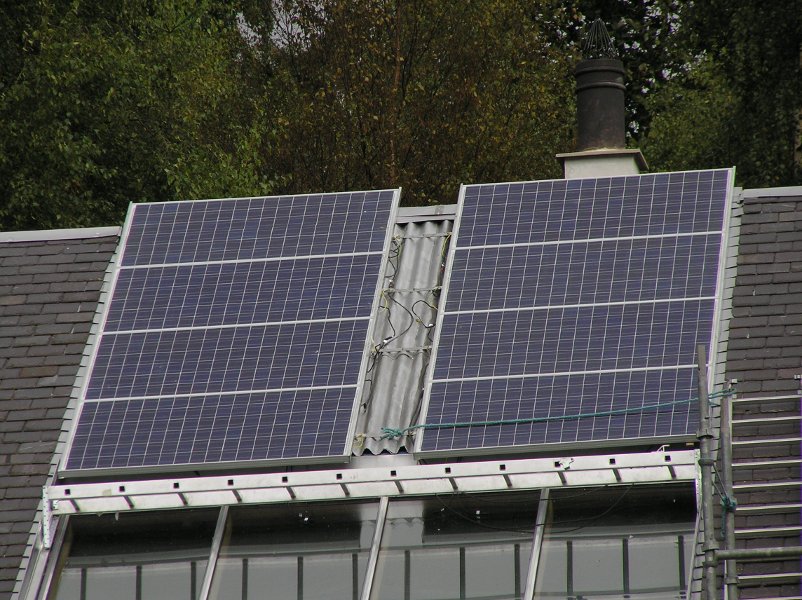
Pic
2: Photovoltaic panels mounted over Onduline (with solar reflective
paint).
An Isokern DM system chimney from Scheidel was chosen as it is highly thermally efficient to the point that it will rarely need cleaning and very little of the energy from the stove is needed to keep the chimney warm. It is simple to erect, like building big Leggo, and costs about the same as the familiar twin wall stainless steel type, much favoured by architects but with quite a short service life and with a rather temporary look to them. The Isokern is made from pumice concrete so it was a simple matter to give it a self coloured, lime rich render. The combination of low cost, high efficiency, long life and low maintenance is unbeatable in my opinion. The product is available from builders’ merchants.
The septic tank is a conventional Balmoral Tanks ‘bottle’ made in Scotland from polythene (more environmentally benign than other materials). Reed beds are constructed on site from geotextile and heavy gauge polythene sheeting.
Sewerage is from Gerberit and is made from HDPE, again a conscious choice to avoid using PVC. The ground is fairly highly permeable so a vertical concrete pipe type soakaway is all that is needed to satisfy requirements for both foul water and storm water disposal.
Because the effluent has been cleaned up by the reed beds it can be recycled for non-potable uses (toilet flushing) in times of drought.
Stick building with Masonite beams follows conventional timber frame practices. Masonite beams are strong, straight, light and rigid but only across their width. Across their thickness they are quite floppy (see pictures) so during construction joist, stud and rafter spacings have to be fixed by nailing temporary battens across them (small section slating batten is ideal).
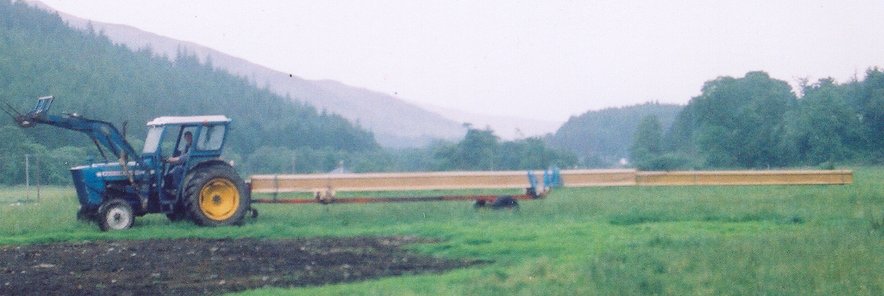
Pic 3: The long beams are 12m but the trailer is only 6m. When on edge they don’t bend.
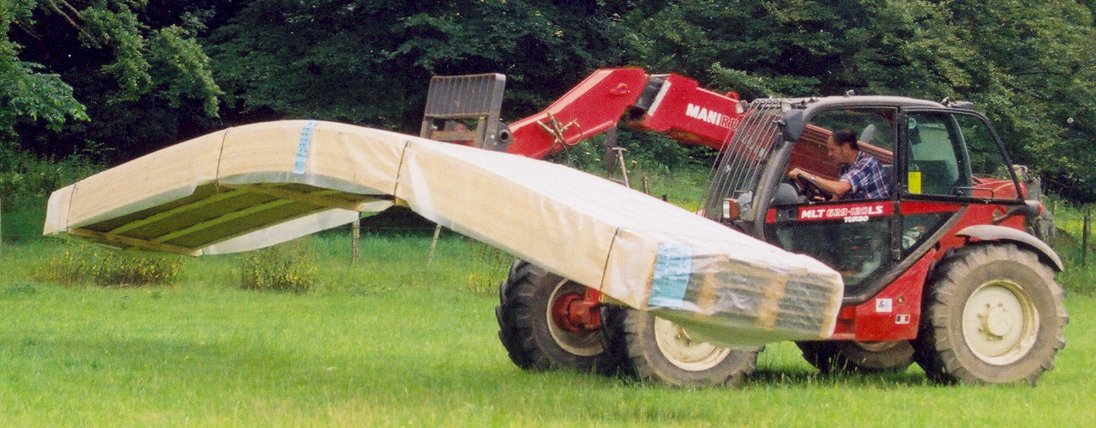
Pic 4: ...but beams on their sides just droop. These are 8.9m.
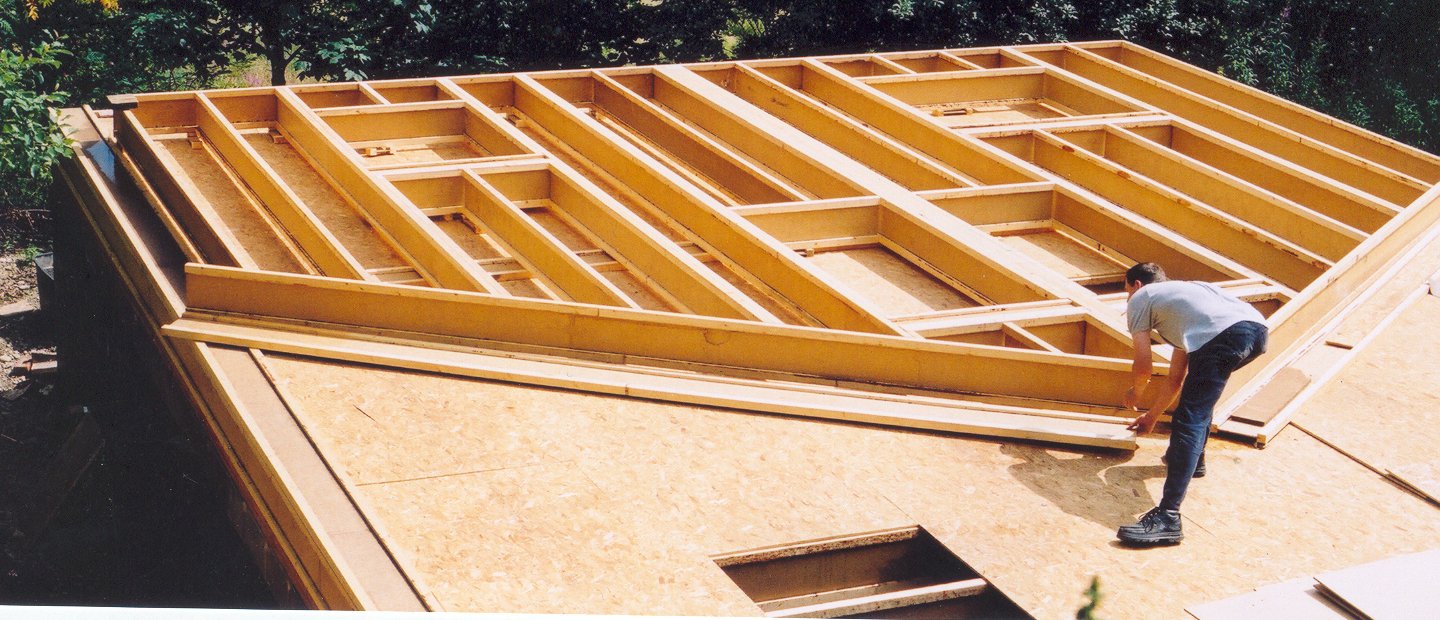
We
got permission to proceed with the foundations which, when completed,
served as a giant workbench on which to pre-fabricate the house.
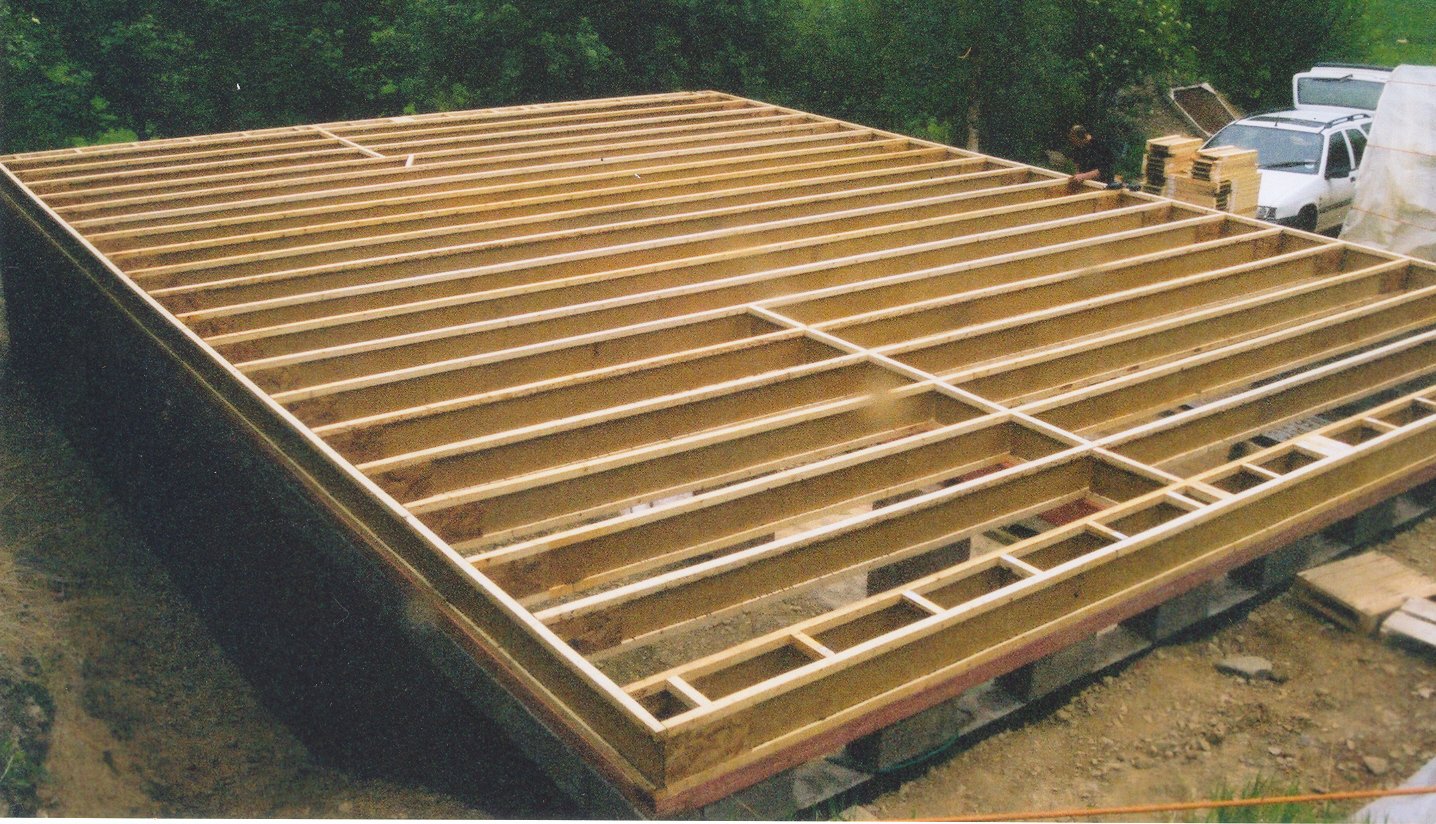
Pic
5: Ground floor frame nearing completion. Note ‘ladders’
at gables.
Pic 6: Pre-fabbing a gable. The carpenter is standing on the completed North wall.
Preparatory to this the dimensions of all the pieces were taken off the drawings and run through a beam cutting optimiser (a computer programme. We used Cut1d). This gave us the pattern of how to cut the bits from our stock of beams with the minimum of waste. From this we printed off sheets of labels to identify the individual pieces (over 500 of them).
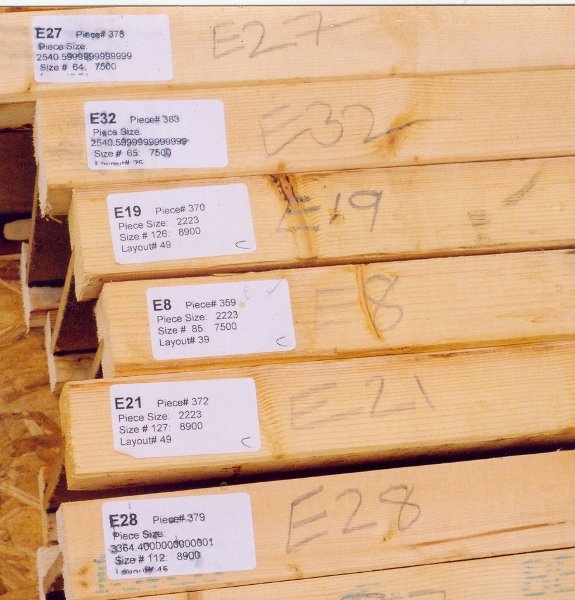
Pic
1: Cut beams stacked with their labels.
Here is an example of the dimensioned drawings
we produced [WestGableDims.
The beams were cut on a large radial arm saw set up in a polytunnel on site with supports to keep flat the 12m beams we were feeding in.
This was laborious but not very complicated. It would have been more worth the effort if we had been building 6 houses but I still think that if we were to build another one we would buy it from Edenframes and have them erect it. Trevor Lowis from Edenframes was happy to tell us in detail how to build our frame. They are the nearest Masonite/Warmcell pre-fab manufacturers (Gretna).
Making up the panels on the flat (front and back walls plus two gable ends) was very straightforward as was the erection done by 6 people and some pulleys. Even the big load bearing studs in the gables and the ridge beam did not present any problems. The rafters were pre cut, lifted into place and nailed together in pairs with their gusset plates before being clipped to the headers and ridge beam. Throughout the erection stud, joist and rafter spacings were held by light battens temporarily nailed in place. I know I've said this before but if you miss out these temporary spacers the beams will flex and the unrestrained lengths will loose their precise spacing so when you come to nail on the sheathing (or later when you want a strong fixing for, say, a partition) you will not be able to find the centre of the stud.
The sheathing went on then the membranes then the cladding.
The TRADA Timber Frame Handbook (ref) tells you how to do wood cladding and ARCA's Timber Cladding In Scotland (ref) tells you why. What neither gives you is a step by step guide. Our experience is that painstaking setting out on the wall (and boards) avoids much redoing and frustration.
The function of cladding is described as a rainscreen, it isn't watertight but prevents rain from reaching the inner insulated shell. Careful detailing ensures that any water penetrating the cladding can drain and ventilation allows it to dry out quickly. Examples of these details include anti-capillarity gaps and chamfered tops to the battens to shed water away from the building.
We went for vertical board on board in larch with horizontal panels in the gable triangles and forming a 'skirt' to break up the visual verticals. Without these horizontal elements we thought that the house would look over-tall and not anchored. An additional plus with the 'skirt' is that it is the bottom of the cladding which perishes first and it is much easier to replace a few horizontal boards than many vertical ones which are still sound for most of their length.
Naturally we went for European larch but were unable to source any locally. Our thinking now is that species is less important than density of wood. Hybrid/Japanese larch is faster growing hence less dense so we selected trees which had grown more slowly (on north facing slopes). We have learned since that the all larch species are comparable in durability which is determined by the concentration in the wood of phenolic extractives.
The board on board has 100x18 front boards with 50x16 back boards so we get 20 overlap on each side and a 10 gap between front boards all fixed through to 22x18 battens on 600 centres.
Illustration
1: Gable showing vertical cladding with horizontal cladding above
and below
The cladding is attached with Gunnebo stainless steel cladding nails. These do not stain the wood (like galvanised nails would) and have slightly domed heads so that you do not hit and mark the wood when you drive them home.
Appropriate energy modelling at the design stage is the only way to ensure that sustainable 'features' actually work to realise a comfortable low-carbon building.
These models are examples only, not the actual models used for the house.
The actual models are being revised along with the drawings and will be published when complete.
Please email edenhope@riseup.net with 'Update' the subject line if you would like to be advised when they are posted.
Sample Passive House model
Sample Photovoltaic model
Sample Solar Thermal model
This section is being assembled. Some drawings call the house 'Westwood' the earlier working title
The drawings listed below are some of the ones submitted for a Building Warrant and have not yet been updated with later amendments or the rest of the house drawings. If you want to be advised when significant updates occur send an e-mail to edenhope@riseup.net with 'Update' as the subject.
The drawings open in a 'frame'. If you right click (or ctrl-click or option-click) anywhere on the drawing your context menu should give you the option to open the 'frame' in a new window or save or print the drawing.
Structural Details: Foundations/Retaining wall:Plan
Structural Details: Foundations/Retaining Wall: Section 01
Structural Details: Foundations/Retaining Wall: Section 02
Structural Details: Underbuilding: Plan, Elevations
Structural Details: Ridge Beam & Roof
Structural Details: 1st Floor & Bay Window
House Drawings: Ground Floor Plan
House Drawings: East Elevation
House Drawings: 1st Floor Plan
House Drawings: West Elevation
House Drawings: South Elevation
House Drawings: Section B-B
House Drawings: Section A-A
House Drawings: Section C-C
House Drawings: Ground Floor Plan: Electrical
House Drawings: Stair
House Drawings: Water
House Drawings: Drainage
A. We have an electric combination oven and an lpg gas hob which uses about 15kg of gas a year. If everyone used that little fossil fuel the global ecosystem would easily be able to cope.
A. We close the windows. Truer than you think, the house is much better at getting warm than getting cold. Even with no-one living in it the internal temperature never went below 5°C even with an external temperature of -10°C. See “Energy Design” section for a fuller explanation.
A. No, We don't need one for heating although we have thought about using one as a back-up water heater.
A heat pump is only as carbon happy as the electricity used to power it so if you power it with ordinary mains electricity it has the same carbon cost as a gas or oil boiler. Our electricity is renewable source so using a heat pump would make good use of our PV power if we needed the heat.
A. The internal solar thermal panel does the bulk of our water heating. We have a small wood-fired boiler stove for back-up. If all else fails we can run an immersion heater from our bio-diesel fuelled generator although it would be much more efficient if we converted it into a into a micro-CHP (Combined Heat and Power) unit. We are still looking out for a small (1.8kW output) heat pump but can only find them in Australia or USA. (Anyone out there, please send us one!)
A. It's a bay window. Sun-space or conservatory give the impression of a separate room which it isn't. The upstairs part is a glazed roof. It is a great benefit in the winter but has solar thermal internal blinds to keep the heat in at night. In summer an awning keeps the sun out.
A. I've never called it one in fact I'm not sure what 'eco-house' means. I used to work in (the science) of ecology and cannot see how it applies to houses. There is an ekistics school in architecture which makes more sense as it considers communities but eco-house doesn't even appear in Wikipedia. It seems to be a rather loose and woolly term – perhaps that's it;: sheeps' wool, turf roofs and composting toilets, a style thing rather than anything strictly to do with sustainability or environmental performance.
I've been trying to do more research on this. I keep seeing 'ecological design' bandied around, I even looked up the definition of ecology used by ecologists but without coming to any useful conclusions. Ecological, like geological, simply defines the universe of discourse doesn't it? Is it simply a pretension like spelling 'passive house' the German way or saying 'methodology' when you mean 'method'.
How do I start a blog?
A. Yes, I'm constantly wandering around feeling the pipes, reading the meter and sensing the air but not in terms of a Post Occupancy Evaluation or recording energy fluxes. I don't have a budget (about £1000) for the equipment. I keep hoping that someone will offer some help because it would be valuable data.
A. Yes and no. The plot was bought with full consent for a (different) house so we had to apply again for our house. There was no problem at all with the design but there was a problem with something, it has never been clear exactly what but we got consent. The only condition affecting the design was that it should have a slate roof which we felt was acceptable.
Similarly with building control, it was all quite straightforward although there was an extra design cost in getting the water system certified.
A. Not asked as often as it should be. We have spent about £135,000 including the plot and everything but there is a standard way of calculating the cost per square meter of a dwelling which leaves out things like design cost and other items not necessarily to do with the house (we were obliged to spend about £3000 upgrading the common access road, for instance). Also we wanted to demonstrate affordability but have the freedom to choose enhancements (like French oak flooring and making it bigger) inconsistent with a strict affordability model.
Also we only built one house. Multiples would be much more cost effective. My guesstimate is that one could build a house substantially like this for less than £100,000. A further complication is that because, for example, the renewable energy systems, can only be sensibly compared on a life cycle rather than capital basis you (not me) would have to add the, say, future energy, water and maintenance costs of a conventional house for a truer comparison.
As mentioned earlier, the affordability of the house can only be assessed over its entire design life. This is a significant departure from the conventional way of costing a project. I am left wondering what sort of moral choice leads the industry to build cheaply and leave the occupants to pick up indefinite higher running costs. With this house we know how much we are paying for power for the next 25 years because we have already paid it.
One day I'll sit down with a friendly Quantity Surveyor to work out exactly what the house cost and what the running costs will be. I'll publish the result. It would make an interesting project for a student.
A. I wish it was an unequivocal 'yes'. All the materials and components are readily available but no one seems to know how to design one. I have begun to see designs by architects who have visited our project but failed to grasp the crucial significance of all the modelling we did to arrive at our design. They seem to think it is done by features, a formulaic approach, which fails to deliver the hoped for performance. Our features are necessitated by the results of our modelling, an integrated solution to what we wished to achieve.
I've started acting either as advocate for clients to ensure they get what they want or partnering with architects to help them deliver the brief.
The authors acknowledge the financial support of the Scottish Borders Woodland Partnership and the personal support of its representatives.


![]()


![]()
A huge “Thank you” to Gokay Devici for crystallising affordability as a combined financial and environmental theme. We hope that with this house we may claim to have followed his model. You may have gathered that I feel like I am drowning in others ideas of low carbon, 'eco-housing', low energy, embodied energy, etc but have always felt safe with the test of affordability.
Any further acknowledgements, no matter how extensive, would be incomplete. You largely know who you are. Perhaps the only ones who underestimate their contribution are the staff at Travis Perkins in Selkirk who have cheerfully and helpfully put up with me from the start.
In this section you will temporarily find bits and pieces which will ultimately be incorporated in the body of the text.